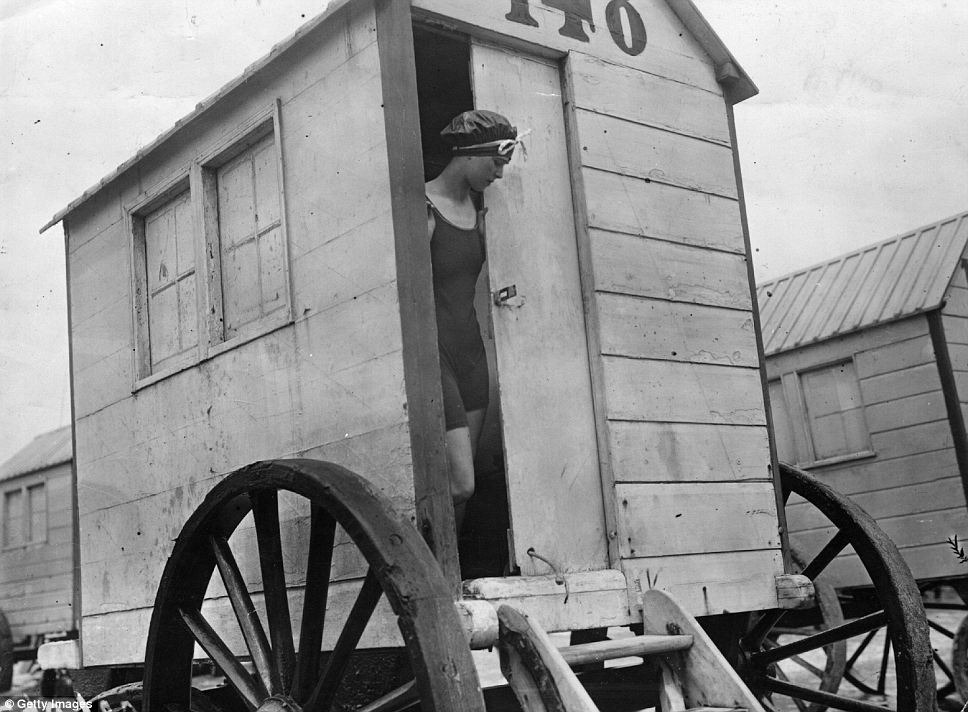Back in the 18th and 19th century, the ladies just couldn't strip to their swimwear and run towards the waves on the beach. There are certain sea-side etiquettes that needed to be observed and decorum to be maintained. Getting oneself seen in their bathing costumes by the members of the opposite sex was certainly not one of them.
To help women maintain their modesty and dignity, a simple contraption called the “bathing machine” was developed. A bathing machine resembled a wooden changing room commonly seen on beaches, but larger in size, and raised on wheels and with steps leading to the inside. The female bather would enter the small room of the machine while it was on the beach, wearing their street clothing. In the privacy of the machine, she would change into her bathing dress, which was exceedingly modest compared to today’s standards, and place her street clothes into a raised compartment where they would remain dry.
Photo credit: unknown/Vintage.es
The bathing machine would then be wheeled into the water by horses, and sometimes by human power. Once the carriage was far out, the bather would emerge from the box using a door that faced away from the prying eyes on the beach. Some machines were equipped with a canvas tent that could be lowered into the water creating a private bathing area for the swimmer. The swimmer was usually escorted by a strong woman, called the dipper, whose job was to assist the lady getting in and out of the machine. Pushing the swimmer into the water, and then yanking her out was not uncommon, and was considered an acceptable part of the experience. If the bather could not swim, a strong cord was encircled around her waist and attached to the end of the van to ensure she was not swept away by the currents.
Once the bather was done, she would go back into the carriage, dry herself and change into her street clothes again. While she was changing, the bather could signal the driver with a small flag that she was ready to return back to the shore. The carriage would be then drawn back to the shore.
Photo credit: unknown/Vintage.es
Bathing machines debuted in the Great Britain around 1750 and spread to the United States, France, and Germany. Its invention is often credited to one Benjamin Beale, a Quaker and a glove and breeches maker who lived in Margate, a coastal seaside resort in England. But this is not true. There is evidence of the existence of the bathing machine at least fifteen years prior. Benjamin Beale, however, did contribute to the design of the bathing machine. The covered canvas hood that could be attached to the rear of the bathing machines, and lowered down to cover the swimmer’s modesty was his invention.
In the earliest days, before the Victorian prudes took hold, it was actually common for men and women alike to swim nude. As moral values changed, nude swimming and even mixed bathing became indecent. Legal segregation of bathing areas finally ended in Britain in 1901, and bathing machines declined rapidly. During its waning days, and with relaxed bathing laws, men and women were often seen riding together in these machines. By the start of the 1920s bathing machines became extinct.
"Mermaids at Brighton" by William Heath (1795 - 1840), c. 1829. Depicts women sea-bathing with bathing machines at Brighton. Photo credit: public domain
“The Costume of Yorkshire”, by George Walker, 1814, depicts a lady being helped out of the bathing machine by her escorts. Photo credit: Leeds Museums and Galleries/Flickr
Photo credit: unknown/Vintage.es
Photo credit: unknown/Vintage.es
A woman perches on the edge of a bathing machine parked in shallow sea on Ostend beach in July 1911. Photo credit: Getty Images
Ostend beach in Belgium in around 1900. Photo credit: Getty Images
Photo credit: unknown/Vintage.es

A young woman emerges from her bathing machine in 1911. Photo credit: Getty Images
Photo credit: Getty Images
Photo credit: unknown/Vintage.es
Photo credit: unknown/Vintage.es
Photo credit: unknown/Vintage.es
Photo credit: unknown/Vintage.es
Photo credit: unknown/Vintage.es
Queen Victoria’s personal bathing machine, restored and displayed at Osborne House where Victoria enjoyed family holidays. Photo credit: grumpylumixuser/Panoramio
Queen Victoria’s personal bathing machine, restored and displayed at Osborne House where Victoria enjoyed family holidays. Photo credit: wondersinthedark.wordpress.com
Sources: Wikipedia / www.victoriana.com / janeaustensworld.wordpress.com





























Comments
Post a Comment